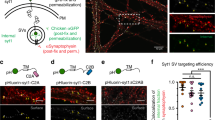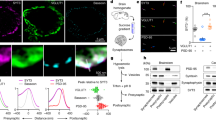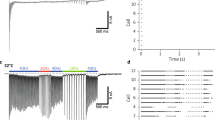Abstract
Spontaneous 'mini' release occurs at all synapses, but its nature remains enigmatic. We found that >95% of spontaneous release in murine cortical neurons was induced by Ca2+-binding to synaptotagmin-1 (Syt1), the Ca2+ sensor for fast synchronous neurotransmitter release. Thus, spontaneous and evoked release used the same Ca2+-dependent release mechanism. As a consequence, Syt1 mutations that altered its Ca2+ affinity altered spontaneous and evoked release correspondingly. Paradoxically, Syt1 deletions (as opposed to point mutations) massively increased spontaneous release. This increased spontaneous release remained Ca2+ dependent but was activated at lower Ca2+ concentrations and with a lower Ca2+ cooperativity than synaptotagmin-driven spontaneous release. Thus, in addition to serving as a Ca2+ sensor for spontaneous and evoked release, Syt1 clamped a second, more sensitive Ca2+ sensor for spontaneous release that resembles the Ca2+ sensor for evoked asynchronous release. These data suggest that Syt1 controls both evoked and spontaneous release at a synapse as a simultaneous Ca2+-dependent activator and clamp of exocytosis.
This is a preview of subscription content, access via your institution
Access options
Subscribe to this journal
Receive 12 print issues and online access
$209.00 per year
only $17.42 per issue
Buy this article
- Purchase on Springer Link
- Instant access to full article PDF
Prices may be subject to local taxes which are calculated during checkout







Similar content being viewed by others
References
Fatt, P. & Katz, B. Spontaneous subthreshold activity at motor nerve endings. J. Physiol. (Lond.) 117, 109–128 (1952).
Glitsch, M.D. Spontaneous neurotransmitter release and Ca2+—how spontaneous is spontaneous neurotransmitter release? Cell Calcium 43, 9–15 (2008).
Chung, C. & Kavalali, E.T. Seeking a function for spontaneous neurotransmission. Nat. Neurosci. 9, 989–990 (2006).
Deitcher, D.L. et al. Distinct requirements for evoked and spontaneous release of neurotransmitter are revealed by mutations in the Drosophila gene neuronal-synaptobrevin. J. Neurosci. 18, 2028–2039 (1998).
Atasoy, D. et al. Spontaneous and evoked glutamate release activates two populations of NMDA receptors with limited overlap. J. Neurosci. 28, 10151–10166 (2008).
Sara, Y., Virmani, T., Deák, F., Liu, X. & Kavalali, E.T. An isolated pool of vesicles recycles at rest and drives spontaneous neurotransmission. Neuron 45, 563–573 (2005).
McKinney, R.A., Capogna, M., Dürr, R., Gähwiler, B.H. & Thompson, S.M. Miniature synaptic events maintain dendritic spines via AMPA receptor activation. Nat. Neurosci. 2, 44–49 (1999).
Carter, A.G. & Regehr, W.G. Quantal events shape cerebellar interneuron firing. Nat. Neurosci. 5, 1309–1318 (2002).
Sutton, M.A. et al. Miniature neurotransmission stabilizes synaptic function via tonic suppression of local dendritic protein synthesis. Cell 125, 785–799 (2006).
Prestwich, S.A., Forda, S.R. & Dolphin, A.C. Adenosine antagonists increase spontaneous and evoked transmitter release from neuronal cells in culture. Brain Res. 405, 130–139 (1987).
Léna, C., Changeux, J.P. & Mulle, C. Evidence for “preterminal” nicotinic receptors on GABAergic axons in the rat interpeduncular nucleus. J. Neurosci. 13, 2680–2688 (1993).
Barazangi, N. & Role, L.W. Nicotine-induced enhancement of glutamatergic and GABAergic synaptic transmission in the mouse amygdala. J. Neurophysiol. 86, 463–474 (2001).
Lambe, E.K., Picciotto, M.R. & Aghajanian, G.K. Nicotine induces glutamate release from thalamocortical terminals in prefrontal cortex. Neuropsychopharmacology 28, 216–225 (2003).
Radcliffe, K.A., Fisher, J.L., Gray, R. & Dani, J.A. Nicotinic modulation of glutamate and GABA synaptic transmission of hippocampal neurons. Ann. NY Acad. Sci. 868, 591–610 (1999).
Simkus, C.R. & Stricker, C. The contribution of intracellular calcium stores to mEPSCs recorded in layer II neurons of rat barrel cortex. J. Physiol. (Lond.) 545, 521–535 (2002).
Grillner, P., Berretta, N., Bernardi, G., Svensson, T.H. & Mercuri, N.B. Muscarinic receptors depress GABAergic synaptic transmission in rat midbrain dopamine neurons. Neuroscience 96, 299–307 (2000).
Llano, I. et al. Presynaptic calcium stores underlie large-amplitude miniature IPSCs and spontaneous calcium transients. Nat. Neurosci. 3, 1256–1265 (2000).
Emptage, N.J., Reid, C.A. & Fine, A. Calcium stores in hippocampal synaptic boutons mediate short-term plasticity, store-operated Ca2+ entry and spontaneous transmitter release. Neuron 29, 197–208 (2001).
Rizo, J. & Rosenmund, C. Synaptic vesicle fusion. Nat. Struct. Mol. Biol. 15, 665–674 (2008).
Yoshihara, M., Adolfsen, B. & Littleton, J.T. Is synaptotagmin the calcium sensor? Curr. Opin. Neurobiol. 13, 315–323 (2003).
Söllner, T.H. Regulated exocytosis and SNARE function. Mol. Membr. Biol. 20, 209–220 (2003).
Xu, J., Mashimo, T. & Sudhof, T.C. Synaptotagmin-1, -2 and -9: Ca2+ sensors for fast release that specify distinct presynaptic properties in subsets of neurons. Neuron 54, 567–581 (2007).
Verhage, M. et al. Synaptic assembly of the brain in the absence of neurotransmitter secretion. Science 287, 864–869 (2000).
Schoch, S. et al. SNARE function analyzed in synaptobrevin/VAMP knockout mice. Science 294, 1117–1122 (2001).
Delgado-Martínez, I., Nehring, R.B. & Sørensen, J.B. Differential abilities of SNAP-25 homologs to support neuronal function. J. Neurosci. 27, 9380–9391 (2007).
Littleton, J.T., Stern, M., Perin, M. & Bellen, H.J. Calcium dependence of neurotransmitter release and rate of spontaneous vesicle fusions are altered in Drosophila synaptotagmin mutants. Proc. Natl. Acad. Sci. USA 91, 10888–10892 (1994).
Maximov, A. & Südhof, T.C. Autonomous function of synaptotagmin 1 in triggering asynchronous release independent of asynchronous release. Neuron 48, 547–554 (2005).
Pang, Z.P., Sun, J., Rizo, J., Maximov, A. & Südhof, T.C. Genetic analysis of synaptotagmin 2 in spontaneous and Ca2+-triggered neurotransmitter release. EMBO J. 25, 2039–2050 (2006).
Geppert, M. et al. Synaptotagmin I: a major Ca2+ sensor for transmitter release at a central synapse. Cell 79, 717–727 (1994).
Elmqvist, D. & Feldman, D.S. Calcium dependence of spontaneous acetylcholine release at mammalian motor nerve terminals. J. Physiol. (Lond.) 181, 487–497 (1965).
Rosenmund, C. & Stevens, C.F. Definition of the readily releasable pool of vesicles at hippocampal synapses. Neuron 16, 1197–1207 (1996).
Fernández-Chacón, R. et al. Synaptotagmin I functions as a calcium regulator of release probability. Nature 410, 41–49 (2001).
Pang, Z.P., Shin, O.-H., Meyer, A.C., Rosenmund, C. & Südhof, T.C. A gain-of-function mutation in synaptotagmin-1 reveals a critical role of Ca2+-dependent SNARE-complex binding in synaptic exocytosis. J. Neurosci. 26, 12556–12565 (2006).
Mackler, J.M., Drummond, J.A., Loewen, C.A., Robinson, I.M. & Reist, N.E. The C2B Ca2+-binding motif of synaptotagmin is required for synaptic transmission in vivo. Nature 418, 340–344 (2002).
Nishiki, T. & Augustine, G.J. Dual roles of the C2B domain of synaptotagmin I in synchronizing Ca2+-dependent neurotransmitter release. J. Neurosci. 24, 8542–8550 (2004).
Stevens, C.F. & Sullivan, J.M. The synaptotagmin C2A domain is part of the calcium sensor controlling fast synaptic transmission. Neuron 39, 299–308 (2003).
Sun, J. et al. A dual Ca2+ sensor model for neurotransmitter release in a central synapse. Nature 450, 676–682 (2007).
Schneggenburger, R. & Neher, E. Intracellular calcium dependence of transmitter release rates at a fast central synapse. Nature 406, 889–893 (2000).
Bollmann, J.H., Sakmann, B. & Borst, J.G. Calcium sensitivity of glutamate release in a calyx-type terminal. Science 289, 953–957 (2000).
Otsu, Y. et al. Competition between phasic and asynchronous release for recovered synaptic vesicles at developing hippocampal autaptic synapses. J. Neurosci. 24, 420–433 (2004).
Hagler, D.J. Jr. & Goda, Y. Properties of synchronous and asynchronous release during pulse train depression in cultured hippocampal neurons. J. Neurophysiol. 85, 2324–2334 (2001).
Ubach, J., Zhang, X., Shao, X., Südhof, T.C. & Rizo, J. Ca2+ binding to synaptotagmin: how many Ca2+ ions bind to the tip of a C2-domain? EMBO J. 17, 3921–3930 (1998).
Fernandez, I. et al. Three-dimensional structure of the synaptotagmin 1 C2B-domain: synaptotagmin 1 as a phospholipid binding machine. Neuron 32, 1057–1069 (2001).
Lois, C., Hong, E.J., Pease, S., Brown, E.J. & Baltimore, D. Germline transmission and tissue-specific expression of transgenes delivered by lentiviral vectors. Science 295, 868–872 (2002).
Han, W. et al. N-glycosylation is essential for vesicular targeting of synaptotagmin 1. Neuron 41, 85–99 (2004).
Maximov, A., Pang, Z.P., Tervo, D.G. & Südhof, T.C. Monitoring synaptic transmission in primary neuronal cultures using local extracellular stimulation. J. Neurosci. Methods 161, 75–87 (2007).
Acknowledgements
We thank I. Kornblum, J. Mitchell, L. Fan and A. Roth for excellent technical assistance, and A. Maximov and C. Zhang for advice.
Author information
Authors and Affiliations
Contributions
J.X., Z.P.P. and O.-H.S. planned, performed and analyzed the experiments. T.C.S. conceived the project, supervised the experiments and wrote the paper.
Corresponding author
Supplementary information
Supplementary Text and Figures
Supplementary Figures 1–9 and Supplementary Table 1 (PDF 5055 kb)
Rights and permissions
About this article
Cite this article
Xu, J., Pang, Z., Shin, OH. et al. Synaptotagmin-1 functions as a Ca2+ sensor for spontaneous release. Nat Neurosci 12, 759–766 (2009). https://doi.org/10.1038/nn.2320
Received:
Accepted:
Published:
Issue Date:
DOI: https://doi.org/10.1038/nn.2320
This article is cited by
-
The release of inhibition model reproduces kinetics and plasticity of neurotransmitter release in central synapses
Communications Biology (2023)
-
Vesicle trafficking and vesicle fusion: mechanisms, biological functions, and their implications for potential disease therapy
Molecular Biomedicine (2022)
-
Cannabinoid receptor activation acutely increases synaptic vesicle numbers by activating synapsins in human synapses
Molecular Psychiatry (2021)
-
Deficiency of SCAMP5 leads to pediatric epilepsy and dysregulation of neurotransmitter release in the brain
Human Genetics (2020)
-
Synaptotagmin-1 enables frequency coding by suppressing asynchronous release in a temperature dependent manner
Scientific Reports (2019)



